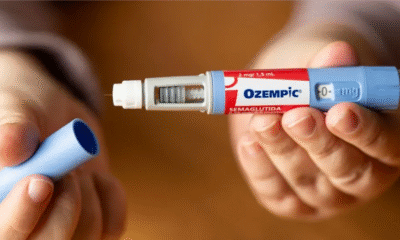Health
Comparing India and the world’s Physical Activity levels and how it can be improved
The main findings show that even though India faired poorly in Government Strategies and Investments, it received slightly above-global-average grades in Overall Physical Activity and Sedentary Behaviour.
Johnson Shoyama School of Public Policy, Canada along with Public Health Foundation of India, in partnership with Edusports came up with a report on Physical activity for children and youth in India. It is a part of Global matrix 2.0, an international initiative that compares 38 countries across six continents.
Using rigorous methods with standardised grades, this is the first assessment of 10 key indicators of physical activity among children and youth in India. We spoke to Dr. Tarun Katapally, Assistant Professor, Shoyama Graduate School of Public Policy, Canada, on the report, its results and what it implies:
MBP: Could you tell us what the aim and objective of the report is?
Dr. Katapally: The India Report Card was developed to assess the current state of physical activity among children and youth, and to help inform active living policies and programming in India (which are currently lacking).
In fact, the development and release of Report Cards on physical activity for children and youth has been used in many countries for advocacy and social mobilization to increase young people’s activity by influencing perceptions, priorities, policies, and practices.
MBP: While we do understand the importance of physical activity for a healthy lifestyle, how does it affect the overall development of a child?
Dr. Katapally: Physical activity is crucial for cognitive development, as children and youth who participate in sports and other physical activities tend to have better academic performance and some studies have linked physical activity with improved memory.
Additionally, sports and physical activities provide children and youth important opportunities to socialise and interact with their peers and develop necessary social and emotional skills.
More importantly, physical activity goes beyond just sport and exercise because we can be highly active and highly sedentary on the same day! For example, we can go to the gym and then end up spending most of the day in sedentary pursuits. That is why we need to focus on active living, which means being physically active throughout the day.
MBP: How does the lack of physical activity or a sedentary lifestyle affect economic prosperity?
Dr. Katapally: According to latest evidence, apart from a clear connection to a wide range of non-communicable diseases, physical inactivity is responsible for 5.3 million deaths/year and costs healthcare systems approximately $67.5 billion/year. These statistics should be a wake-up call for all governments. With respect to India, a country with a growing burden of non-communicable diseases, and whose children and youth will make up a major proportion of the world’s workforce in the future, it is extremely important that a national strategy for physical activity of children and youth is established.
MBP: The report is an international initiative that compares 38 countries and the results have varied from place to place. India is a country that has a multitude of cultures, how does this make an impact?
Dr. Katapally: Culture plays a critical role in determining whether physical activity is valued, as well as what types of physical activity a society would engage (i.e., dance and yoga versus certain types of organized sport). India is a diverse country and different regions would take different approaches to physical activity. It is important to have an understanding of these differences, as well as the cultural norms, when designing physical activity policies or programs.
MBP: How has the feedback from parents been?
Dr. Katapally: Unfortunately, there are no valid data for parents in India and other middle income countries. We hope that the Report Card would raise the awareness of the burden of physical inactivity and help kick start active living research in India. There is time to make an impact with the Report Card, but the sooner people know about the situation in India, the better it would be.
MBP: Demography, security and mindsets make up a large portion of letting children walk or cycle, how can this be tackled?
Dr. Katapally: This is an excellent question! I think to address these issues the burden has to be shared by the governments at different levels (union, state and local), schools and communities, and parents and educators.
India has some unique challenges when it comes to demographics and perception of environment (safety, security etc.) and overall mindsets. I think the union government has a major role to play in driving a national strategy to not only raise awareness of the burden of physical inactivity on health and economy, but also to make appropriate investments for research and physical activity programming. This strategy should bring into the fold the state and local governments, and schools and parents, because without them actual action on the ground will not materialise. And as we are such a diverse nation, the policies and programs should be tailored to take into consideration cultural and geographic variation.
More importantly, to make a real change, a number of sectors need to work together because active living policies require cross-governmental agreements, and partnerships across urban design, transportation, education and public health organizations.
For example, for us to be active and move freely, we need our towns and cities to be pedestrian and bike friendly. Current evidence indicates that Indian cities have low walkability ratings due to poor and unsafe infrastructure. More importantly, a key determinant of walkability that is often not measured in Western countries is air pollution. About 78% of 141 cities in India exceed the acceptable standard of particulate matter (PM2.5) exposure. 90 cities reported critical levels, and 26 reported levels of PM2.5 exceeding the acceptable standard by three times.
MBP: What, according to you, could be done to help?
Dr. Katapally: To change this situation and help people to move without fear or safety or pollution, we would need a national clean energy policy combined with local urban planning and transportation policy that would help enable the creation of SMART ACTIVE COMMUNITIES.
In conclusion, the burden needs to be shared by all stakeholders (governments, schools, communities, parents and educators), and for this to happen, we would require education of all stakeholders to raise their knowledge about the perils of physical inactivity in children and youth.
In the Report Card, we have put forward 6 Recommendations to improve the levels of physical activity among Indian children and youth. These Recommendations address all the points of ideas/policies and its funding. These need to be reported and highlighted.
The global comparisons of the research were led by Dr. Mark Tremblay, Director of the Healthy Active Living and Obesity Research Group at the Children’s Hospital of Eastern Ontario Research Institute (HALO-CHEO) in Canada. The primary stakeholders of the India Report Card are policy makers, researchers, parents, teachers, and health professionals. Dr. Katapally, EduSports and team hope that the Report Card garners their attention enough to address the current challenges for active living in India.











































